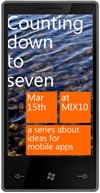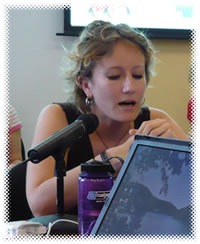Welcome to another installment of Counting Down to Seven, a series of articles about mobile app development that I’m writing as we count down the days to MIX10, when we reveal more about the up-and-coming Windows Phone 7 Series.
Who are the Millennials?
In Andy Hunt’s book, Pragmatic Thinking and Learning (which we’re covering in Ignite Your Coding in a couple of days!), there’s a chapter devoted to recognizing and compensating for your cognitive biases. In that chapter, there’s a section titled Recognize Your Generational Affinity, and it begins with this quote from Douglas Adams:
Anything that is in the world when you’re born is normal and ordinary and just a natural part of the way the world works.
Anything that is invented between when you’re fifteen and thirty-five is new and exciting and revolutionary and you can probably get a career in it.
Anything invented after you’re thirty-five is against the natural order of things.
It’s an interesting quote to keep in mind when discussing that demographic known as “Millennials” or “Generation Y”. While there aren’t any hard and fast rules for defining the boundaries of a generation, it’s generally accepted that when we’re talking about Millennials, we’re referring to a group of people born after 1982.
Here’s a quick video introduction to the Millennial Generation from Futurist.com [length 8:04]:
By Douglas Adams’ maxim above, even the oldest members of this generation, who were 15 in 1997, would consider the web and mobile phones that actually fit in your pocket as normal and ordinary and just a natural part of the way the world works. Members of this generation who are in university or just about to enter the job market probably can’t even remember a world where the internet and mobile phones weren’t household items.
How Millennial are You?
I followed a tweet from my friend, co-worker and fellow Generation Xer David Crow which lead me to the Pew Research Center’s How Millennial Are You? Quiz. David scored 51/100, which suggests that his tendencies fall somewhere between Generation X and Millennial. Here are my results:

I don’t know how I should feel about that score (I was born in 1967). Millennial tendencies or not, I don’t think you’re going to hear me blasting any Justin Bieber tunes out of my car anytime soon.
(Go ahead, take the quiz. If you feel like sharing, tell me your score in the comments!)
Millennials: Under the Microscope and With Mobile Phones
The quiz led me to the Pew Research Center’s study titled Millennials: A Portrait of Generation Next [1.25 MB PDF]. It’s subtitled with “Confident. Connected. Open to Change.”, and it’s a pretty interesting read if you’re the sort of person who likes to know what makes people tick (and if you know me, I’m just that sort of person). It’s also worth reading – at least parts of it are – if you’re planning to get into developing for Windows Phone 7 (and yes, any other vendor’s smartphone platform, but those don’t pay my bills).
Millennials grew up in the networked world and spent at least part of their adolescent years in the era of what Microsoft Research’s danah boyd calls “networked publics”. They’re the first “always connected” generation, having grown up with broadband, wifi and mobile devices. They’re more technophilic than previous generations, as the chart below shows:

(Note the use of the phrase “cell phone” – clearly an Xer or Boomer wrote the study.)
The stats about mobile phones are worth repeating:
- 88% of Millennials use their mobile phone to send text messages
- 80% have texted in the past 24 hours
- 64% have texted while driving (how you do this, I don’t even know)
- Of those who’ve texted in the past 24 hours, the median number of texts they have sent and received is 20.
Here’s another observation: 83% of Millennials sleep with their mobile phones nearby, according to the chart below:

Most Millennials have a mobile phone, and many of them have the mobile as their only phone (as opposed to having a land line at home):

Millennials are also big on wireless ‘net access:

In the past 24 hours, Millennials are more likely to have watched an online video, posted a message to an online profile and played a video game than the other generations. Here’s a chart showing “Past 24 Hours” activities for various generations:

Motorola on Millennials
Given the Millennials’ technophilic tendencies, it’s not surprising that a number of high-tech companies have researched this generation. Here are a couple of videos posted by Motorola Media Center:
Microsoft on Millennials and Money
The Empire has also done some studies on Millennials. One of the most recent was on the difference between the way Boomers and Millennials deal with banks:
- Millennials are much more likely than Boomers to use web banking (49% versus 35%)
- See online service capabilities as important when researching a bank (54% versus 42%)
- Care less about doing transactions in person at a bank branch (32% versus 44%)
Summary
Keep the Millennials in mind when you’re thinking about apps to write for Windows Phone 7. Think of the sorts of application that would appeal to people who:
- Don’t think of mobile phones as just phones that fit in your pocket, but as remote controls for the world.
- Send a lot of text messages, sometimes at inadvisable times.
- Always have their phones close by, even when they’re asleep.
- Are bigger videogame players than any previous generation.
- Are more likely to have their mobile phone as their primary and sole phone.
What needs would they have? What goals would arise from those needs? What user contexts would they have, and how would you use them to filter what your apps would present to them?

